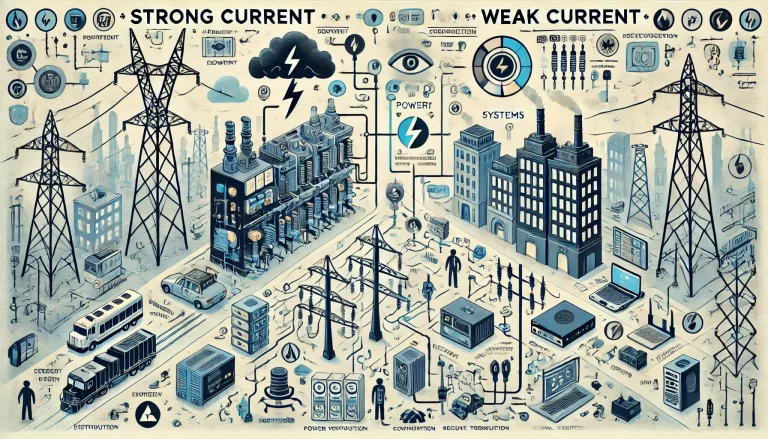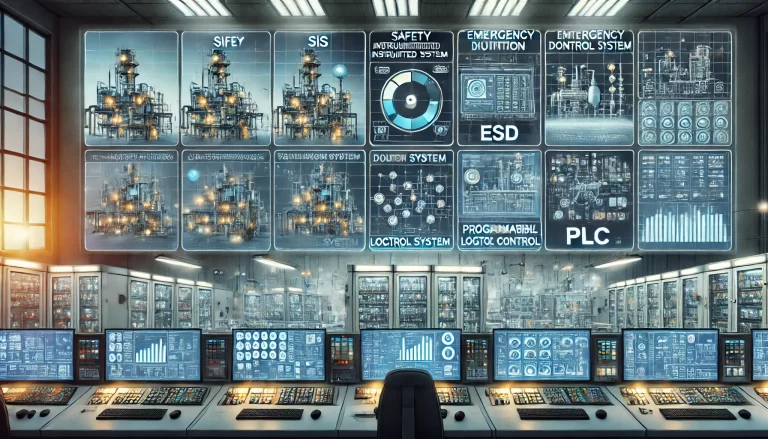In the field of electrical engineering, “strong current” and “weak current” are two fundamental concepts. These two types of electrical systems have distinct characteristics and serve different functions, with each playing an important role in modern technology. Let’s take a closer look at how they differ in terms of voltage, current, applications, safety considerations, and transmission.
1. Voltage and Current Levels
Strong Current (Power): This category generally refers to electrical systems with high voltage and high current. The typical voltage for strong current systems is 220 volts (V) and above, with industrial power often using 380V or higher. This high voltage is essential for delivering large amounts of power needed to operate machinery, heating systems, lighting, and other high-energy-consuming equipment.
Weak Current (Signal): Weak current systems operate at low voltage and low current levels, typically below 36V. Common voltages in weak current systems include 5V, 12V, and 24V, often found in network cables, electronic devices, and communication lines. For example, household data cables and phone lines usually operate within this low voltage range, which suffices for carrying data signals without needing high power.

2. Purpose and Applications
Strong Current (Power): Strong current systems are primarily used to transport and convert electrical energy to meet the demands of devices that require a substantial amount of power. They are commonly found in residential, commercial, and industrial settings, supplying power for lighting, HVAC systems, heavy machinery, and electric motors. In essence, strong current systems are the backbone of the power distribution network that keeps our homes, cities, and industries running.
Weak Current (Signal): Weak current systems are designed for signal transmission, data processing, and control functions. They are crucial in communication and information technologies, including telecommunication networks, computer networks, and monitoring systems. Examples include the data transmission within a Wi-Fi network, security systems like CCTV, or control circuits in industrial automation. Unlike strong current systems, weak current systems focus on the accuracy and integrity of the signals rather than power output.
3. Safety and Human Impact
Strong Current (Power): Due to the high voltage and current, strong current systems pose a significant risk to human safety if not handled properly. Direct contact with high-voltage electricity can cause serious injury or even be fatal. As a result, safety measures such as insulation, grounding, circuit breakers, and personal protective equipment are crucial in environments where strong current systems are present. These systems are also regulated under strict safety codes and standards to prevent accidents.
Weak Current (Signal): Weak current systems, by contrast, generally operate at a voltage low enough to pose minimal risk of electrical shock to humans. Therefore, they are often considered safer to work with, making them suitable for everyday electronic devices and communications systems where human interaction is frequent. Nonetheless, electrical standards still apply to ensure the safety and functionality of these systems.
4. Transmission Distance and Efficiency
Strong Current (Power): Strong current systems are designed to transmit power over long distances. High voltage levels are necessary to reduce power loss during transmission, which is why power lines often carry electricity at hundreds of thousands of volts over long distances to reduce losses due to resistance. This is especially important in national and regional power grids that distribute electricity over vast distances.
Weak Current (Signal): Weak current systems typically involve shorter transmission distances, focusing on areas such as local area networks (LANs), building control systems, or short-distance telecommunications. Weak current signals tend to degrade over longer distances, so they often require signal boosters or repeaters to maintain data integrity if extended beyond typical short distances.

5. Cabling and Equipment Differences
Strong Current (Power): Given the high voltage and current, strong current systems require cables with thick insulation and a high level of durability. Copper or aluminum conductors are commonly used, often encased in thick, protective insulation to prevent short circuits and reduce risks associated with high power transmission. Additionally, strong current systems require equipment capable of handling large currents and protecting against overloads, such as transformers, switchgear, and circuit breakers.
Weak Current (Signal): In weak current systems, cables are thinner and generally have simpler insulation layers because of the lower power and voltage requirements. Common materials for weak current cabling include copper or fiber optics, which are used for efficient data transmission. The equipment needed for weak current systems, such as routers, modems, and network switches, focuses more on signal processing and data transmission rather than raw power handling.
Summary of Strong and Weak Current Differences
| Aspect | Strong Current (Power) | Weak Current (Signal) |
|---|---|---|
| Voltage and Current | High voltage and high current (e.g., 220V+) | Low voltage and low current (e.g., 5V–36V) |
| Main Purpose | Power distribution and energy conversion | Data and signal transmission, control functions |
| Safety Considerations | Requires rigorous safety measures and insulation | Generally safe, minimal risk of electric shock |
| Transmission Distance | Long-distance transmission (e.g., power grids) | Short-distance transmission (e.g., LANs) |
| Cabling and Equipment | Thick cables, robust insulation, heavy-duty devices | Thin cables, basic insulation, signal equipment |
Integration of Strong and Weak Current Systems
While strong and weak current systems are often separated, they frequently coexist and complement each other in modern technology. For example, in smart homes and industrial automation, strong current systems provide the power supply, while weak current systems handle data transmission and control commands. This integration allows for intelligent systems where energy use and equipment operation can be monitored, adjusted, and controlled effectively.

Conclusion
The distinction between strong and weak current systems is essential in understanding the diverse functions of electrical systems in our daily lives. Strong current focuses on delivering and converting power for high-demand devices, whereas weak current systems prioritize the integrity and transmission of signals for communication and control. This complementary relationship enables complex infrastructures such as power grids, smart cities, and modern communication networks to function seamlessly. Understanding these differences can help us appreciate the role each plays in the ever-evolving landscape of technology and energy management.
Both strong and weak current systems are indispensable in today’s interconnected world, and as technology advances, the interplay between the two is likely to become even more integrated, leading to more efficient and innovative solutions across various fields.
